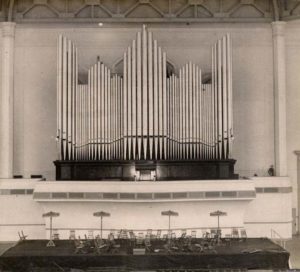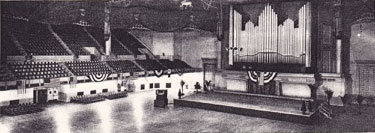
During my high school years the Civic Auditorium was often used for graduations and religious events. A friend of mine and I often visited church organ lofts to write down specifications and play these instruments if we were able. On one particular occasion I had the opportunity to be at Civic during a rehearsal when the original console had been rolled out and prepared for use. I started writing down the specification in my little notebook when Louis Schoenstein confronted me and asked what I thought I was doing. He was not happy. I started asking him a few questions about the console and the instrument. He softened a little and actually took me on a tour of the main windchest that a person could enter through an airlock. The main chest interior was very large, supposedly large enough for a table to seat 75 for dinner. I was able to reach up and cause a note above to sound by pulling a pipe valve. My recollection is that another airlock allowed a person to go from that ten inch pressure to the fifteen inch pressure through another airlock. The Austin Universal Chest is unique in that the mechanism can be worked on while the blower(s) are on.

Years later my recollection of the original console reminded me of a curiosity that remained over the years. I had a very strong impression that the pedal drawstops were located on the righthand side of the console as opposed to the traditional placement on the left. The replacement console built in the sixties followed the traditional placement on the left. When the 1914 console was located and saved by John Rust in the early 2000s, his photographs showed the draws were on the left. I suspected that somewhere along the way the pedal drawstops were moved to the left. Checking the specifications and carefully examining old photographs of the 1914 console, it became clear that my recollection from high school days was correct: originally the pedal stops were on the right.